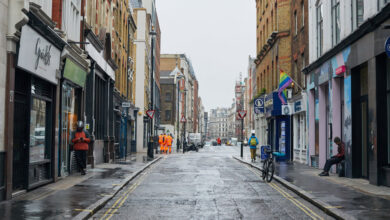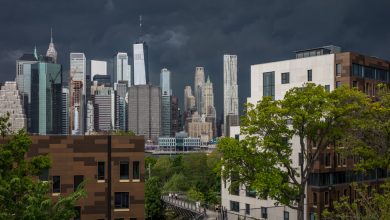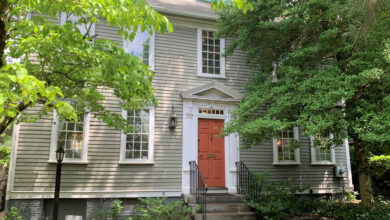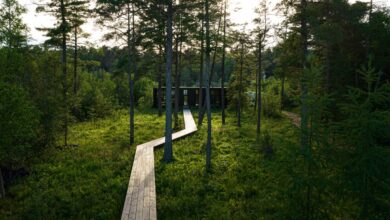The Art-Filled Studios Gertrude Whitney Left Behind
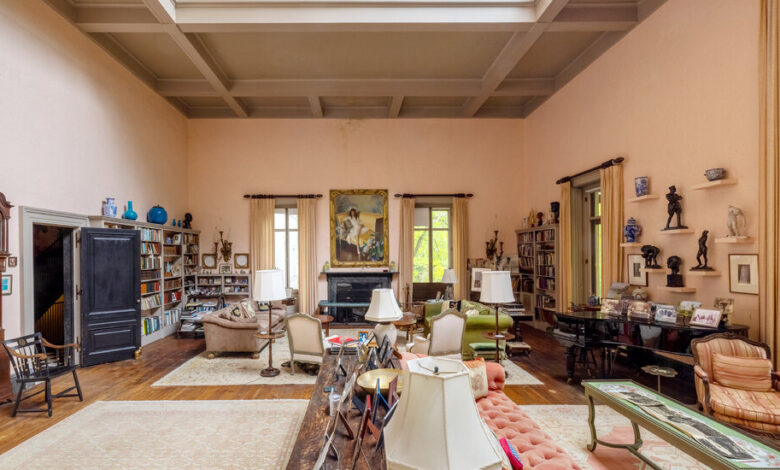
The sculptor Gertrude Vanderbilt Whitney, a bohemian aristocrat, left behind a sturdy legacy of patronage in the institution she founded: The Whitney Museum of American Art. But the long-term survival of two exuberantly decorated studios where she made her own artwork, one in Greenwich Village and one in the Long Island town of Old Westbury, is in doubt.
The Long Island studio, the last fragment to be sold off from what was once a thousand-acre Whitney family estate, was recently put on the market for $4.75 million. And though Whitney descendants have maintained the studio as a kind of shrine to their illustrious forebear and hope to find a buyer who prizes its history as much as they do, there is nothing besides good will and good taste to keep a new owner from razing the structure, which contains lush, built-in artworks Mrs. Whitney commissioned for the space.
The Greenwich Village studio, a former hayloft at 19 Macdougal Alley that she bought in 1907, was the first piece of a complex of four contiguous townhouses and rear carriage houses on West Eighth Street that Mrs. Whitney bought over time and ultimately transformed into the Whitney Museum’s first home in 1931. The whole compound has been owned since 1967 by the New York Studio School of Drawing, Painting, and Sculpture.
A great-granddaughter of the railroad baron Cornelius Vanderbilt, Gertrude Vanderbilt was born in 1875 and grew up in the ostentatious chateau of her father, Cornelius Vanderbilt II, at 1 West 57th Street. She married the sportsman Harry Payne Whitney, also a wealthy heir, in 1896.
Mrs. Whitney was a forward-thinking champion of contemporary American artists at a time when American museums and collectors generally reserved their wall space for European art, confining their interest in American works to the safely academic. And her patronage extended to inviting fellow artists to decorate her own private work spaces.
The centerpiece of the Macdougal Alley studio is a breathtaking sculptural inferno of bronze and plaster flames that surge up the outside of a 20-foot-tall fireplace, consuming tiny tormented figures along the way, before searing the coved periphery of a phantasmagorical ceiling that teems with bas-relief celestial bodies and beasts: a grinning anthropomorphized sun, serpents, a dragon and a pair of octopi engaged in hand-to-hand-to-hand combat.
This brazen, three-dimensional act of imagination was perpetrated by Mrs. Whitney’s friend Robert Winthrop Chanler, a hard-living, hard-loving Astor scion whose work was featured in the groundbreaking 1913 New York Armory show. But the Whitney studio, a National Historic Landmark, has suffered. The ceiling and fireplace, once ablaze with vivid colors, were whitewashed sometime in the distant past, and in 2008 a small portion of the ceiling’s curved cornice collapsed.
The World Monuments Fund provided a $50,000 grant to develop a better understanding of its construction and materials. The Kaitsen Woo architecture firm concluded that the cornice detachment had been an isolated incident, and the ceiling was ultimately deemed stable. Scholars were then retained, from 2008 to about 2013, to further investigate the ceiling and fireplace and develop conservation strategies.
But at this point, the space has been studied within an inch of its life, and no formal maintenance or even basic crack-monitoring program is in place, notwithstanding the fissures that run through the ceiling’s curved cornice. The windows are drafty, and temperature control is so rudimentary that a recent visit found plastic sheets covering the interiors of the two pairs of hayloft doors.
“That’s making me very nervous,” said Alex Williams, the Studio School’s development director, as she pointed up at a crack bisecting a mermaid at the ceiling’s edge. “Sometimes I don’t even want to look up at the ceiling — it’s very stressful.”
In 2014, the National Trust for Historic Preservation named the studio a national treasure and provided $30,000, which was used to repair the floor and to install a new lighting system.
The school appealed to individuals and foundations for donations for additional conservation, Ms. Williams said, but success was elusive. Currently there is no fund-raising effort underway for restoration, as the school already has its hands full raising money to support its central educational mission.
“This is an endangered space — it has been for many years — and it’s the problem of paralysis by analysis,” said Lauren Drapala, an architectural conservator who studied the ceiling extensively. Because Mr. Chanler’s original complex color scheme is hidden behind layers of white paint, “there are so many unanswered questions about how that space looked that any intervention could be potentially catastrophic,” she said. “So I think there’s a fear that if we do anything we could destroy it, but in the meantime it’s not accessible and not being repaired and this leaves concerns for its long-term longevity.”
Mrs. Whitney’s studio in Old Westbury, near the mansion she shared — unhappily — with her philandering husband, was built in 1912 to plans by the society architects Delano & Aldrich.
This was no garret. Reminiscent of an Italian villa, and complemented by a formal garden and a pool, the limestone structure had a spacious central work space with a 20-foot-high skylight through which poured the northern light prized by artists. This studio, too, was adorned with artworks by Mr. Chanler: a bedroom wrapped in a gloomy, medieval-themed mural and a Jules Verne-inflected bathroom with a sunken marble tub of deep green.
The painter Jerome Myers recalled in awe an opening party where he beheld “sunken pools and gorgeous white peacocks as line decorations into the gardens” as well as “brilliant macaws nodding their beaks.” Inside, he encountered “Chanler showing us his exotic sea pictures” and “Mrs. Whitney displaying her studio, the only place on earth in which she could find solitude.”
Subsequent parties at the studio drew the likes of Albert Einstein and Charles Lindbergh. For one soiree, Mr. Chanler sent two kangaroos, which were placed in the empty pool for partygoers to gawk at.
Mr. Chanler — who shared his own self-described House of Fantasy and annex on East 19th Street in Manhattan with exotic animals like a spider monkey, herons, and flamingoes — exercised a certain allure for Mrs. Whitney.
“How fine he is in his way,” she wrote in her diary. “Put aside the fact of his being a fraud and a flirt, and he is inspiring. … Listen, listen with a thousand ears to what he says.”
The studio stood unused and deteriorating after Mrs. Whitney’s death in 1942, until Pamela LeBoutillier, a granddaughter, converted it into a home in 1982 by adding a wing to either side. She moved in with a son and daughter, one of whom, John LeBoutillier, still lives there.
“My mother revered Gertrude,” with whom she had lived for a year as a young woman, Mr. LeBoutillier, 67, said. “My mother said, ‘We’re going to put the studio to the way it was when I was a child visiting here.’”
In the central workplace, a hook that was once part of a block-and-tackle mechanism hangs above a trap door in the floor. “She’d be up here working with her male assistants, and when the piece was done, they would lower it through the trap door into the cellar,” Mr. LeBoutillier said. “And they’d put it on a cart, and a pony would pull it down through a tunnel to the kilns.”
Among the homages to Mrs. Whitney, the family recreated her long-demolished Paris bedroom, removing her bed, dressing table and other personal items from storage and furnishing the chamber to match an old family painting of the Paris room.
Mrs. Whitney, who studied with Auguste Rodin, described her sculptures as “emotions gouged from clay.” Her favorite sibling, Alfred Vanderbilt, was aboard the Lusitania, a British ocean liner, when it was torpedoed by a German U-boat in 1915. After giving his life vest to a woman with a baby, he drowned, devastating Mrs. Whitney.
In 1982, in the studio basement, her descendants found a plaster maquette for her proposed memorial for victims of the Lusitania sinking. The maquette depicted a mother and baby in a lifeboat held aloft by lost souls.
Though the memorial was never built, the emotional costs of war made an enormous impact on Mrs. Whitney. The studio’s grounds are decorated with bronze sculptures of struggling World War I doughboys, and her Washington Heights-Inwood War Memorial stands at Mitchel Square in Upper Manhattan.
The studio’s collection of built-in artworks has been eroded over time. In 1999, to raise funds for a relative’s medical expenses, the family sold off a mural set by Maxfield Parrish that depicted Renaissance troubadours and celebrants. And the sinuous main staircase was originally adorned with a vibrant, wraparound mural that included a portrait of Mrs. Whitney in an androgynous avant-garde ballet outfit. The work was made by her friend Howard Gardiner Cushing, whom Mr. LeBoutillier believes was also her lover. But the mural that decorates the staircase today is a replica; the original was sold about four years ago to Cushing descendants.
Before the pandemic, Whitney Museum curators were interested in exhibiting the Cushing mural, but a museum spokeswoman said that there are currently no plans to do so. She added that the museum could not afford to buy the Long Island studio.
The Macdougal Alley studio has also lost some artworks. Mr. Chanler envisioned the room as an immersive experience that included a decorative screen and seven stained-glass windows depicting a Boschian jumble of fantastical creatures. All of these were removed long ago. Five of the windows languished at a nearby antiques store until they were ultimately purchased by James Alexandre, a Pennsylvania collector who also acquired the other two, one of which had once served as a shower door for a Whitney descendant. Mr. Alexandre said that, if asked, he would consider allowing digital reproductions of the windows to be made and installed in the Macdougal studio.
Mrs. Whitney used her expanding real estate holdings on West Eighth Street to exhibit the work of emerging American artists, whose creations she also steadily purchased. In 1929, she sent her assistant, Juliana Force, to offer her collection of more than 600 contemporary American artworks to the Metropolitan Museum of Art. The Met turned down the gift, and Mrs. Whitney responded by using her vast wealth to open what might be called, with apologies to Virginia Woolf, a “museum of one’s own.”
Progress on restoring Mrs. Whitney’s Village studio has been stymied in part by technical challenges that came to light during studies by teams from the University of Pennsylvania and New York University’s Institute of Fine Arts, with additional leadership from the architectural conservator Mary A. Jablonski.
In the cases of both the fireplace and ceiling, which are coated with multiple layers of white paint, “it’s pretty difficult, if not impossible, to get back to the original layer without destroying it,” said Bonnie Burnham, a board member of the Studio School who was also chief executive of the World Monuments Fund when the studies were performed. She added that any restoration would necessarily be speculative and that the studio space “is at odds with the central mission of the school, and there are just so many question marks and so many competing priorities for the institution that nothing has really moved forward.”
For now, the school’s immediate goals for the room extend no further than repairing the windows.
Meanwhile, that Village studio and the Long Island studio are both “incredibly imperiled,” said Gina Wouters, a co-editor of the book “Robert Winthrop Chanler: Discovering the Fantastic.”
“It’s the integral nature of the artwork that’s been the problem” in these spaces that were originally so private, she said. “It’s like a brilliant conundrum that Whitney and Chanler created for us: How do you preserve them and how do you make them accessible, when it’s almost impossible to do either?”
For weekly email updates on residential real estate news, sign up here. Follow us on Twitter: @nytrealestate.


